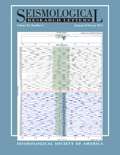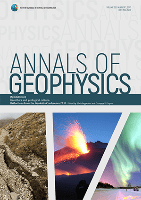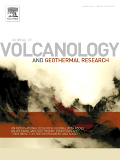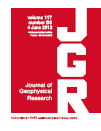
SEISMOLOGICAL RESEARCH LETTERS
Scope & Guideline
Illuminating the earth's secrets through dedicated research.
Introduction
Aims and Scopes
- Seismic Monitoring and Analysis:
The journal emphasizes the importance of continuous seismic monitoring through the deployment of advanced sensor networks and data analysis techniques. Studies often focus on the detection, characterization, and interpretation of seismic events, including earthquakes, induced seismicity, and volcanic activity. - Machine Learning and Data Science Applications:
There is a significant focus on the integration of machine learning techniques to enhance seismic event detection, classification, and forecasting. This includes the application of deep learning algorithms to improve data processing and analysis in seismology. - Volcanology and Seismoacoustic Studies:
Research on volcanic activity, including the monitoring of volcanic tremors and eruptions, is a consistent theme. This includes the use of seismoacoustic data to understand volcanic processes and assess hazards. - Earthquake Hazard Assessment and Risk Mitigation:
The journal publishes studies that assess seismic hazards and risks, contributing to the development of models and strategies for earthquake preparedness and response. - Geophysical Imaging and Modeling:
A core area of research involves the development and application of geophysical imaging techniques, such as seismic tomography and inversion methods, to elucidate subsurface structures and fault dynamics. - Historical and Paleoseismology:
Research into historical earthquakes and paleoseismicity provides insights into long-term seismic behavior and risk assessment, contributing to a better understanding of seismic hazards over time.
Trending and Emerging
- Real-Time Monitoring and Early Warning Systems:
There is a growing emphasis on developing systems for real-time monitoring of seismic activity and early warning capabilities, utilizing advancements in technology and data processing to enhance public safety. - Integration of Environmental and Anthropogenic Factors:
Research increasingly explores the interactions between seismicity and environmental changes, including those induced by human activity such as hydraulic fracturing and geothermal energy extraction. - Data Sharing and Open-Access Initiatives:
The trend towards open access and sharing of seismic data is rising, facilitating collaboration and transparency in research, and allowing for broader access to valuable datasets. - Interdisciplinary Approaches in Seismology:
There is an emerging trend toward interdisciplinary research that integrates seismology with fields such as geophysics, geology, and data science, promoting holistic understanding of seismic phenomena. - Artificial Intelligence and Automation in Seismology:
The application of AI and automation in seismic event detection and data analysis is rapidly growing, enhancing the efficiency and accuracy of seismic monitoring systems.
Declining or Waning
- Traditional Seismology without Advanced Technology:
There has been a noticeable decrease in studies that rely solely on traditional seismic monitoring methods without the integration of modern technologies such as machine learning or advanced data processing techniques. - Localized Case Studies:
While localized case studies have been a staple in seismological research, there has been a waning interest in narrowly focused studies that do not leverage broader datasets or collaborative efforts across regions. - Conventional Earthquake Prediction Methods:
Research centered around conventional earthquake prediction models has become less prominent, as the field increasingly embraces probabilistic and data-driven approaches. - Static Models of Seismic Hazards:
There is a decline in the focus on static models for seismic hazard assessment, with a shift toward dynamic models that incorporate variability and uncertainty in seismicity.
Similar Journals

Ingegneria Sismica
Connecting researchers to enhance earthquake engineering insights.Ingegneria Sismica, a premier journal published by PATRON EDITORE S R L, serves as an essential platform for the dissemination of research in the fields of building and construction, geotechnical engineering, and safety risk management. With a focus on earthquake engineering and structural safety, the journal has established itself as a prominent source of knowledge since its inception in 2010. The journal holds an impressive Q2 classification in multiple categories, including Building and Construction and Geotechnical Engineering, reflecting its significant impact within these disciplines. Despite its Italian roots, it appeals to an international audience of researchers, professionals, and students dedicated to advancing the understanding of seismic resilience and risk mitigation strategies. Although open access is not currently available, the potential for knowledge sharing and innovative methodologies presented in the articles continues to attract a robust readership. With its commitment to excellence and relevance, Ingegneria Sismica is poised to shape future discourse in engineering practices aimed at enhancing safety, reliability, and quality within seismic zones.

CHINESE JOURNAL OF GEOPHYSICS-CHINESE EDITION
Exploring the Depths of Earth Science InnovationCHINESE JOURNAL OF GEOPHYSICS-CHINESE EDITION, published by SCIENCE PRESS, stands as a prominent platform for the dissemination of cutting-edge research in the fields of Geophysics and Geochemistry. Since its inception in 1979, this esteemed journal has successfully converged a wealth of knowledge, boasting a substantial impact factor and a recognized standing within the academic community, evidenced by its Q2 categorization in both Geochemistry and Petrology and Geophysics as of 2023. Researchers, professionals, and students looking to stay abreast of the latest advancements in solid-earth sciences will find the journal's comprehensive articles and studies invaluable. Based in Beijing, China, the journal emphasizes a broad scope, encompassing various aspects of geophysical research and methodologies. Although it does not currently offer open access options, its commitment to quality research makes it a crucial resource for the scientific community.

ANNALS OF GEOPHYSICS
Innovating Solutions for Environmental ChallengesANNALS OF GEOPHYSICS is a prestigious open access journal dedicated to the advancement and dissemination of research in the field of geophysics. Published by the IST NAZIONALE DI GEOFISICA E VULCANOLOGIA in Italy, this journal has embraced open access since its inception in 1948, promoting wide accessibility to cutting-edge research. With an impressive Scopus ranking, placing it in the 52nd percentile within Earth and Planetary Sciences for the category of Geophysics, the journal serves as a vital platform for scholars, researchers, and practitioners seeking to explore the intricate phenomena of our planet. Covering a diverse range of topics in the geophysical community, the ANNALS OF GEOPHYSICS invites contributions that push the boundaries of our knowledge and understanding of geophysical processes, aiding in the development of innovative solutions to urgent environmental challenges. Published continuously from 2002 to 2024, the journal’s commitment to quality and rigor is reflected in its Q3 quartile ranking for 2023, making it a notable resource for the academic community.

JOURNAL OF VOLCANOLOGY AND GEOTHERMAL RESEARCH
Charting New Territories in Volcanic and Geothermal StudiesWelcome to the Journal of Volcanology and Geothermal Research, a premier publication dedicated to advancing the understanding of volcanic and geothermal processes. Published by Elsevier in the Netherlands, this esteemed journal holds a distinguished Q1 ranking in both Geochemistry and Petrology and Geophysics, reflecting its influential contribution to the field. Since its inception in 1976, the journal has served as a critical platform for high-quality research, disseminating cutting-edge findings that shape the discourse surrounding Earth sciences. With an impressive Scopus ranking—27th in Geophysics and 43rd in Geochemistry and Petrology—scholars and practitioners alike regard it as an essential resource for staying informed on the latest research trends. Although it does not provide open access options, the journal remains committed to enriching the academic community's understanding of geothermal energy, volcanic hazards, and related geophysical phenomena, making it a must-read for anyone invested in these dynamic fields.

Earthquakes and Structures
Pioneering research to withstand nature's tremors.Earthquakes and Structures is a prestigious academic journal published by TECHNO-PRESS, dedicated to the field of Civil and Structural Engineering. Since its inception in 2010, this journal has provided a platform for innovative research and practical applications, addressing critical challenges related to seismic activities and their impact on infrastructure. With an ISSN of 2092-7614 and an E-ISSN of 2092-7622, it is indexed in top databases, reflecting its commitment to quality and relevance, as indicated by its Q3 quartile ranking in 2023. The journal encompasses a wide range of topics, from theoretical investigations to real-world case studies, appealing to researchers, professionals, and students alike. By fostering interdisciplinary collaboration and disseminating cutting-edge findings, Earthquakes and Structures plays an essential role in advancing knowledge and practices in earthquake engineering, enhancing global resilience against seismic threats.

JOURNAL OF GEOPHYSICAL RESEARCH-SOLID EARTH
Leading the Charge in Solid Earth DiscoveriesJOURNAL OF GEOPHYSICAL RESEARCH-SOLID EARTH is a prestigious journal published by the American Geophysical Union, dedicated to advancing the study of solid Earth sciences. With an ISSN of 2169-9313 and E-ISSN of 2169-9356, it serves as a leading platform for rigorous research findings and innovative advancements within the fields of Earth and Planetary Sciences, Geochemistry and Petrology, Geophysics, and Space and Planetary Science. The journal has achieved an impressive Q1 quartile ranking across these categories, reflecting its high impact in the academic community and underscoring its role in influencing scientific discourse. Notably, it holds an esteemed position in Scopus, ranking 15th among 159 journals in Earth and Planetary Sciences (miscellaneous) as well as within the top 20 in several other geophysical domains. Researchers and practitioners are encouraged to contribute their work to this esteemed journal, which publishes comprehensive articles from 1979 to the present, thus providing a crucial repository of knowledge for those engaged in solid Earth research. Although it does not currently offer Open Access options, the journal's prestigious reputation ensures its articles reach a wide audience of academics, professionals, and students alike, fueling a deeper understanding of our planet's processes and challenges.

BULLETIN OF THE SEISMOLOGICAL SOCIETY OF AMERICA
Advancing seismic knowledge for a safer tomorrow.BULLETIN OF THE SEISMOLOGICAL SOCIETY OF AMERICA is a premier journal published by the Seismological Society of America, dedicated to advancing research in the field of seismology and related disciplines. Since its inception in 1969, this journal has garnered significant recognition, evidenced by its impressive Q1 category rankings in both Geochemistry and Petrology, and Geophysics, alongside a solid standing within the Earth and Planetary Sciences Scopus rankings. The journal is esteemed for publishing high-quality, peer-reviewed articles that contribute to the understanding of seismic activities and their implications on a global scale. With a commitment to facilitating the dissemination of critical findings, it serves as an essential resource for researchers, professionals, and students alike who are engaged in the dynamic and vital study of the Earth’s processes. While the journal is not Open Access, it continues to provide vital insights and methodologies that shape the future of geophysical research.

TECTONOPHYSICS
Connecting Science and Innovation in Earth SciencesTECTONOPHYSICS is a leading journal published by Elsevier that has been at the forefront of earth and planetary sciences since its inception in 1964. With both its print and e-ISSN identifiers (0040-1951 and 1879-3266), the journal offers a reputable platform for disseminating high-quality research in Earth-Surface Processes and Geophysics, proudly positioned in the Q1 category for both fields in 2023. With a Scopus ranking of #43 out of 179 in Earth-Surface Processes and #43 out of 165 in Geophysics, TECTONOPHYSICS demonstrates a strong impact, making it an essential resource for researchers and professionals involved in the geological and geophysical sciences. Published in the Netherlands, TECTONOPHYSICS is committed to advancing knowledge in tectonics and related disciplines, fostering innovative research that impacts our understanding of Earth's dynamic processes. The journal invites contributions that push the boundaries of science, making it a must-read for academia and industry alike.

Geofizicheskiy Zhurnal-Geophysical Journal
Fostering Collaboration in Earth Surface DynamicsGeofizicheskiy Zhurnal-Geophysical Journal, published by the esteemed S I Subbotin Institute of Geophysics, National Academy of Sciences of Ukraine, stands as a vital resource for professionals and researchers in the field of geophysics. With an ISSN of 0203-3100 and an E-ISSN of 2524-1052, this journal is recognized for its rigorous peer-reviewed articles that delve into various aspects of geophysical research, including seismic studies, geodynamics, and Earth surface processes. Although currently not under an open access model, the journal maintains a commitment to disseminating high-quality research, thereby enriching the global geophysical community. The publication aims to foster collaboration and knowledge transfer among scientists and engineers while addressing complex geophysical challenges in a rapidly evolving landscape. By engaging with cutting-edge research, readers can expect to uncover insights that advance both theoretical understanding and practical applications in geophysical science.

Geofisica Internacional
Elevating Research Standards in Geophysics Since 1975Geofisica Internacional, an esteemed academic journal published by the Instituto de Geofísica at UNAM, Mexico's prestigious National Autonomous University, has been a pivotal platform for advancing the field of geophysics and energy studies since its inception in 1975. This Open Access journal aims to disseminate high-quality research findings, making significant contributions to our understanding of Earth's processes and energy resources. With a current impact factor that situates it in the Q3 category for both Energy (miscellaneous) and Geophysics, it provides a continuous dialogue for researchers, professionals, and students interested in the intersection of these critical areas. Based in Mexico City and publishing articles that span various geophysical disciplines, Geofisica Internacional is indispensable for anyone seeking to stay at the forefront of environmental and energy research.